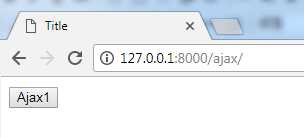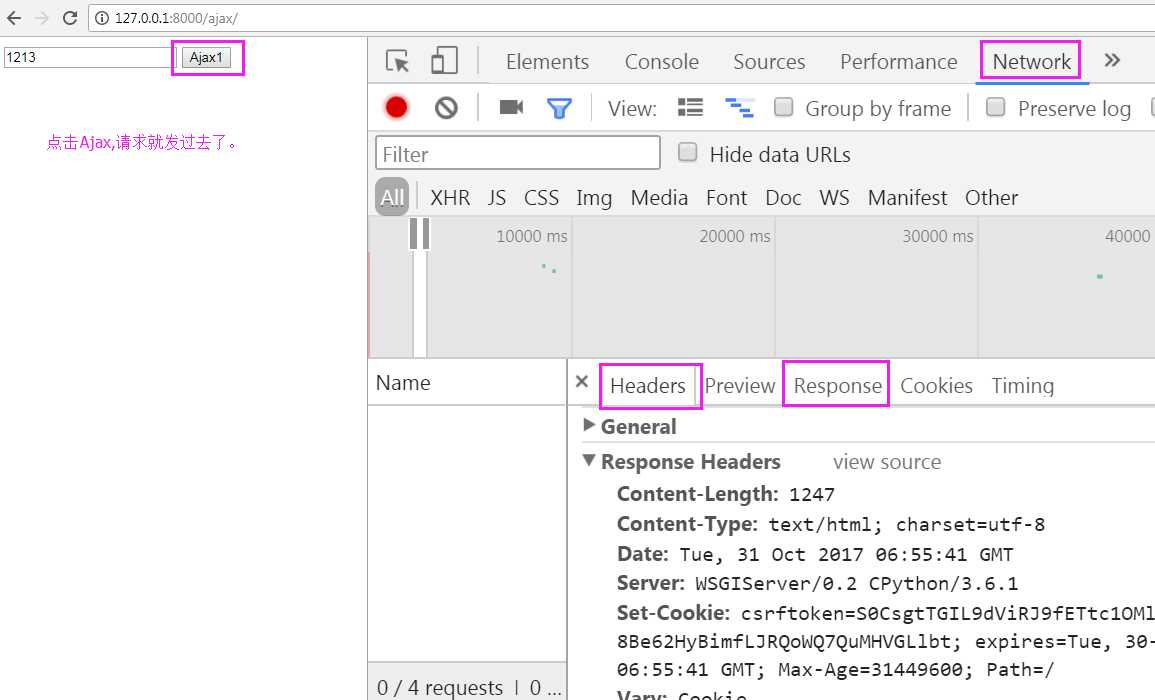标签:title json 参数 问题 send stat 说明 text char
参考老师博客:http://www.cnblogs.com/wupeiqi/articles/5703697.html
一,原生Ajax
Ajax主要就是使用 【XmlHttpRequest】对象来完成请求的操作,该对象在主流浏览器中均存在(除早起的IE),Ajax首次出现IE5.5中存在(ActiveX控件)。
JQuery提供的Ajax方法:
$.ajax({
url: ,
type: ‘‘,
dataType: ‘‘,
data: {
},
success: function(){
},
error: function(){
}
})
一般来说,大家可能都会习惯用JQuery提供的Ajax方法,但是用原生的js怎么去实现Ajax方法呢?
Ajax的实现主要分为四部分:
1、创建Ajax对象
// 创建ajax对象
var xhr = null;
if(window.XMLHttpRequest){
xhr = new XMLHttpRequest(); //// XMLHttpRequest对象用于在后台与服务器交换数据
} else {
//为了兼容IE6
xhr = new ActiveXObject(‘Microsoft.XMLHTTP‘);
}
2、连接服务器
// 连接服务器open(方法GET/POST,请求地址, 异步传输) xhr.open(‘GET‘, ‘data.txt‘, true);
说明:open(method, url, async) 方法需要三个参数:
method:发送请求所使用的方法(GET或POST);与POST相比,GET更简单更快,并且在大部分情况下都能用;然而,在以下情况中,请使用POST
url:规定服务器端脚本的 URL(该文件可以是任何类型的文件,比如 .txt 和 .xml,或者服务器脚本文件,比如 .asp 和 .php (在传回响应之前,能够在服务器上执行任务));
async:规定应当对请求进行异步(true)或同步(false)处理;true是在等待服务器响应时执行其他脚本,当响应就绪后对响应进行处理;false是等待服务器响应再执行。
3、发送请求,将请求送往服务器。
// 发送请求 xhr.send();
4、接收返回数据
// 处理返回数据 /* ** 每当readyState改变时,就会触发onreadystatechange事件 ** readyState属性存储有XMLHttpRequest的状态信息,存有服务器响应的状态信息。
** onreadystatechange:存有处理服务器响应的函数,每当 readyState 改变时,onreadystatechange 函数就会被执行。 ** 0 :请求未初始化 ** 1 :服务器连接已建立 ** 2 :请求已接受 ** 3 : 请求处理中 ** 4 :请求已完成,且相应就绪 */ xhr.onreadystatechange = function(){ if(xhr.readyState == 4){ /* ** Http状态码 ** 1xx :信息展示 ** 2xx :成功 ** 3xx :重定向 ** 4xx : 客户端错误 ** 5xx :服务器端错误 */ if(xhr.status == 200){ success(xhr.responseText); //获得字符串形式的响应数据。 } else { if(failed){ failed(xhr.status); } } } }
5.Ajax封装函数示例:
function Ajax(type, url, data, success, failed){
// 创建ajax对象
var xhr = null;
if(window.XMLHttpRequest){
xhr = new XMLHttpRequest();
} else {
xhr = new ActiveXObject(‘Microsoft.XMLHTTP‘)
}
var type = type.toUpperCase();
// 用于清除缓存
var random = Math.random();
if(typeof data == ‘object‘){
var str = ‘‘;
for(var key in data){
str += key+‘=‘+data[key]+‘&‘;
}
data = str.replace(/&$/, ‘‘);
}
if(type == ‘GET‘){
if(data){
xhr.open(‘GET‘, url + ‘?‘ + data, true);
} else {
xhr.open(‘GET‘, url + ‘?t=‘ + random, true);
}
xhr.send();
} else if(type == ‘POST‘){
xhr.open(‘POST‘, url, true);
// 如果需要像 html 表单那样 POST 数据,请使用 setRequestHeader() 来添加 http 头。
xhr.setRequestHeader("Content-type", "application/x-www-form-urlencoded");
xhr.send(data);
}
// 处理返回数据
xhr.onreadystatechange = function(){
if(xhr.readyState == 4){
if(xhr.status == 200){
success(xhr.responseText);
} else {
if(failed){
failed(xhr.status);
}
}
}
}
}
// 测试调用
var sendData = {name:‘asher‘,sex:‘male‘};
Ajax(‘get‘, ‘data/data.html‘, sendData, function(data){
console.log(data);
}, function(error){
console.log(error);
});
1、XmlHttpRequest对象介绍
什么是 XMLHttpRequest 对象?
XMLHttpRequest 对象用于在后台与服务器交换数据。XMLHttpRequest 对象是开发者的梦想,因为您能够:
所有现代的浏览器都支持 XMLHttpRequest 对象。
1.1 XmlHttpRequest对象的主要方法:
a. void open(String method,String url,Boolen async)
用于创建请求
参数:
method: 请求方式(字符串类型),如:POST、GET、DELETE...
url: 要请求的地址(字符串类型)
async: 是否异步(布尔类型)
b. void send(String body)
用于发送请求
参数:
body: 要发送的数据(字符串类型)
c. void setRequestHeader(String header,String value)
用于设置请求头
参数:
header: 请求头的key(字符串类型)
vlaue: 请求头的value(字符串类型)
d. String getAllResponseHeaders()
获取所有响应头
返回值:
响应头数据(字符串类型)
e. String getResponseHeader(String header)
获取响应头中指定header的值
参数:
header: 响应头的key(字符串类型)
返回值:
响应头中指定的header对应的值
f. void abort()
终止请求
1.2. XMLHttprequest对象来发生原生Ajax数据的示例
views.py
def ajax(request):
return render(request,‘ajax.html‘)
Ajax.html
<!DOCTYPE html>
<html lang="en">
<head>
<meta charset="UTF-8">
<title>Title</title>
</head>
<body>
<input type="button" value="Ajax1" onclick="Ajax1();"/>
<script>
function Ajax1(){
var xhr=new XMLHttpRequest(); //创建XMLHttpRequest对象
xhr.open(‘GET‘,‘/index/‘,true); //指定用什么形式发,发到哪里,是否异步(是)
xhr.send("name=root;pwd=123"); //发送的数据
}
</script>
</body>
</html>
页面效果:


1.3 不往Ajax页面发了,往ajax_json处发。修改程序
views.py
def ajax(request):
return render(request,‘ajax.html‘)
def ajax_json(request):
ret={‘status‘:True,‘data‘:None} #字典
import json
return HttpResponse(json.dumps(ret))
ajax.html
<!DOCTYPE html>
<html lang="en">
<head>
<meta charset="UTF-8">
<title>Title</title>
</head>
<body>
<input type="text"/>
<input type="button" value="Ajax1" onclick="Ajax1();"/>
<script>
function Ajax1(){
var xhr=new XMLHttpRequest(); //创建XMLHttpRequest对象
xhr.open(‘GET‘,‘/ajax_json/‘,true); //指定用什么形式发,发到哪里,是否异步(是)
xhr.send("name=root;pwd=123"); //发送的数据
}
</script>
</body>
</html>
urls.py
from django.conf.urls import url
from django.contrib import admin
from app01 import views
urlpatterns = [
url(r‘^admin/‘, admin.site.urls),
url(r‘^index/‘, views.index),
url(r‘^user_list/‘, views.user_list),
url(r‘^edit-(\d+)/‘, views.user_edit),
url(r‘^ajax/$‘, views.ajax),
url(r‘^ajax_json/$‘, views.ajax_json),
url(r‘^orm/‘, views.orm),
]
访问页面

1.4 XmlHttpRequest对象的主要属性:
a. Number readyState
状态值(整数)
详细:
0-未初始化,尚未调用open()方法;
1-启动,调用了open()方法,未调用send()方法;
2-发送,已经调用了send()方法,未接收到响应;
3-接收,已经接收到部分响应数据;
4-完成,已经接收到全部响应数据;
b. Function onreadystatechange #回调函数
当readyState的值改变时自动触发执行其对应的函数(回调函数)
c. String responseText
服务器返回的数据(字符串类型)
d. XmlDocument responseXML
服务器返回的数据(Xml对象)
e. Number states
状态码(整数),如:200、404...
f. String statesText
状态文本(字符串),如:OK、NotFound...
1.5 在前端页面上拿到返回值。
ajax.html
<!DOCTYPE html>
<html lang="en">
<head>
<meta charset="UTF-8">
<title>Title</title>
</head>
<body>
<input type="text"/>
<input type="button" value="Ajax1" onclick="Ajax1();"/>
<script>
function Ajax1(){
var xhr=new XMLHttpRequest(); //创建XMLHttpRequest对象
xhr.open(‘GET‘,‘/ajax_json/‘,true); //指定用什么形式发,发到哪里,是否异步(是)
xhr.onreadystatechange=function(){
if(xhr.readyState==4){
//接收完毕,放到XMLHttprequest对象里面了
console.log(xhr.responseText);
}
};
xhr.send("name=root;pwd=123"); //发送的数据
}
</script>
</body>
</html>
1.6 返回状态码
def ajax(request):
return render(request,‘ajax.html‘)
def ajax_json(request):
ret={‘status‘:True,‘data‘:None} #字典
import json
return HttpResponse(json.dumps(ret),status=404,reason=‘Not Found‘)
1.7 代码保存,发生GET请求
ajax.html
<!DOCTYPE html>
<html lang="en">
<head>
<meta charset="UTF-8">
<title>Title</title>
</head>
<body>
<input type="text"/>
<input type="button" value="Ajax1" onclick="Ajax1();"/>
<script>
function Ajax1(){
var xhr=new XMLHttpRequest(); //创建XMLHttpRequest对象
xhr.open(‘GET‘,‘/ajax_json/‘,true); //指定用什么形式发,发到哪里,是否异步(是)
xhr.onreadystatechange=function(){
if(xhr.readyState==4){
//接收完毕,放到XMLHttprequest对象里面了
var obj=JSON.parse(xhr.responseText);
console.log(obj);
}
};
xhr.setRequestHeader(‘k1‘,‘v1‘); //发送的时候带着请求头,csrf的时候用。
xhr.send("name=root;pwd=123"); //发送的数据
}
</script>
</body>
</html>
views.py
def ajax(request):
return render(request,‘ajax.html‘)
def ajax_json(request):
ret={‘status‘:True,‘data‘:None} #字典
import json
return HttpResponse(json.dumps(ret),status=404,reason=‘Not Found‘)
1.8 用原生的Ajax发送POST请求:一定要记住需要设置请求头。
views.py
def ajax(request):
return render(request,‘ajax.html‘)
def ajax_json(request):
print(request.POST)
ret={‘status‘:True,‘data‘:None} #字典
import json
return HttpResponse(json.dumps(ret),status=404,reason=‘Not Found‘)
Ajax.html
<!DOCTYPE html>
<html lang="en">
<head>
<meta charset="UTF-8">
<title>Title</title>
</head>
<body>
<input type="text"/>
<input type="button" value="Ajax1" onclick="Ajax1();"/>
<script>
function Ajax1(){
var xhr=new XMLHttpRequest(); //创建XMLHttpRequest对象
xhr.open(‘POST‘,‘/ajax_json/‘,true); //指定用什么形式发,发到哪里,是否异步(是)
xhr.onreadystatechange=function(){
if(xhr.readyState==4){
//接收完毕,放到XMLHttprequest对象里面了
var obj=JSON.parse(xhr.responseText);
console.log(obj);
}
};
xhr.setRequestHeader(‘k1‘,‘v1‘); //发送的时候带着请求头,csrf的时候用。
xhr.setRequestHeader(‘Content-Type‘, ‘application/x-www-form-urlencoded; charset-UTF-8‘);
//设置请求头,判断发来的请求头里面,怎么样把数据打包的。这样后台就知道怎么样去解了。
xhr.send("name=root;pwd=123"); //发送的数据
}
</script>
</body>
</html>
效果:

1.9, 浏览器的兼容性问题
var xhr=new XMLHttpRequest(); //创建XMLHttpRequest对象
二,jQuery的Ajax
标签:title json 参数 问题 send stat 说明 text char
原文地址:http://www.cnblogs.com/momo8238/p/7763556.html